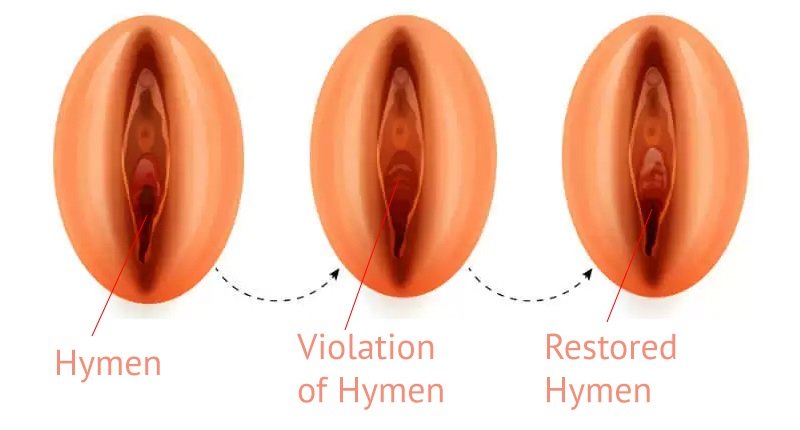Enquire Now
Virginity Surgery Specialist In Nagpur, also known as hymenoplasty, is a surgical procedure that aims to reconstruct or repair the hymen, a thin membrane that partially covers the opening of the vaginal canal. The hymen can naturally stretch or tear for various reasons, including physical activity, tampon use, or sexual intercourse. Some individuals seek hymenoplasty for cultural, religious, or personal reasons, often with the intention of restoring the appearance of an intact hymen, which may be associated with virginity in some cultures.Visit Our Clinic Or more info contact us!
Hymenoplasty is a relatively simple surgical procedure that involves repairing or reconstructing the hymen. The surgeon may use tissue from the vaginal walls to create a new hymen or suture the existing tissue to narrow the vaginal opening.

symptoms vaginal tightening
Pain and Discomfort: After hymenoplasty, some individuals may experience mild to moderate pain or discomfort in the vaginal area. This discomfort is usually temporary and can be manage with over-the-counter pain relievers or medications prescribe by the surgeon.
Swelling: Swelling around the surgical site is common and should subside within a few days to a week after the procedure.
Bleeding: Some individuals may experience minor vaginal bleeding or spotting in the days following hymenoplasty. This is generally normal and should resolve on its own. If bleeding is excessive or prolonged, it’s important to contact a healthcare provider.
Bruising: Bruising around the surgical area may occur and should gradually fade over time.
Sutures: The surgeon may use dissolvable sutures to close the incisions. These sutures will typically dissolve on their own within a few weeks.
Activity Restrictions: Patients are often advised to refrain from strenuous physical activities, including sexual intercourse, for a specific period following the procedure to allow for proper healing.
treatment process
Medical Evaluation: The healthcare provider will conduct a medical evaluation to assess the individual’s overall health and suitability for the surgery. They will also examine the vaginal area to determine the condition of the hymen.
Procedure: Hymenoplasty is usually performed on an outpatient basis and may be done under local or general anesthesia, depending on the individual’s preference and the surgeon’s recommendation. The surgeon will repair or reconstruct the hymen using existing vaginal tissue or by using tissue from the vaginal walls. Sutures or dissolvable stitches may be use to close the incisions.
Recovery: Recovery time following hymenoplasty is relatively short. Patients are typically advise to avoid strenuous physical activities and sexual intercourse during the healing period, which typically lasts a few weeks. Mild discomfort, swelling, and bruising are common during the initial recovery phase.
Follow-Up Care: Patients should schedule follow-up appointments with their healthcare provider to ensure that the surgical site is healing properly and to address any concerns or complications.
Temporary Nature: It’s essential to understand that hymenoplasty does not guarantee or prove virginity in the long term. The repair hymen can be stretche or torn again through various activities, including sexual intercourse or physical exercise.
Confidentiality: Healthcare providers are bound by patient confidentiality, and the information regarding the procedure is typically kept private unless the individual consents to sharing it.
Risk Factors in Virginity Surgery
Infection: As with any surgical procedure, there is a risk of infection at the surgical site. Proper sterile techniques and post-operative care are essential to minimize this risk.
Bleeding: Some bleeding is common after hymenoplasty, but excessive bleeding can occur, particularly if the sutures do not hold or if the patient engages in strenuous activities too soon after the procedure.
Pain and Discomfort: Pain and discomfort are common after the surgery and can persist for several days to weeks. Pain management and following post-operative care instructions are crucial.
Scarring: Hymenoplasty can leave visible scars at the site of the surgical repair. These scars may or may not be noticeable and can vary in appearance from person to person.
Failure to Achieve Desire Results: The success of hymenoplasty can vary, and there is no guarantee that the reconstruct hymen will look or function exactly like a natural hymen. The outcome may not meet the patient’s expectations.
Psychological Impact: Some individuals may experience emotional or psychological distress after undergoing hymenoplasty. This can be due to the stress of the procedure, unrealistic expectations, or feelings of guilt or shame.
Injury to Surrounding Tissues: During the surgery, there is a risk of inadvertently damaging surrounding vaginal tissues, which can lead to complications.
Allergic Reactions: Some individuals may have allergic reactions to anesthesia or other medications use during the procedure. It’s important to disclose any allergies to the medical team.
